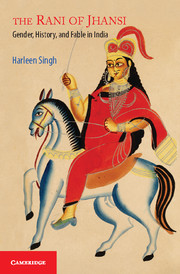Book contents
- Frontmatter
- Dedication
- Contents
- List of Figures
- Acknowledgements
- I Introduction
- II Enslaving Masculinity: Rape Scripts and the Erotics of Power
- III India's Aryan Queen: Colonial Ambivalence and Race in the Mutiny
- IV Coherent Pasts in Hindi Literature and Film
- V Unmaking the Nationalist Archive: Gender and Dalit Historiography
- Afterword
- Bibliography
- Index
III - India's Aryan Queen: Colonial Ambivalence and Race in the Mutiny
Published online by Cambridge University Press: 05 July 2014
- Frontmatter
- Dedication
- Contents
- List of Figures
- Acknowledgements
- I Introduction
- II Enslaving Masculinity: Rape Scripts and the Erotics of Power
- III India's Aryan Queen: Colonial Ambivalence and Race in the Mutiny
- IV Coherent Pasts in Hindi Literature and Film
- V Unmaking the Nationalist Archive: Gender and Dalit Historiography
- Afterword
- Bibliography
- Index
Summary
As discussed in the previous chapter, representations of 1857 often cohered in the metaphors of a disintegrating marriage. Yet, there was another narrative – a disjunctive love story of sorts that in some literary portrayals gave the Rani of Jhansi, variously vilified as a ‘murderous whore’ and ‘India's Jezebel’, a heroic aspect. Published in 1901, Michael White's novel Lachmi Bai Rani of Jhansi: The Jeanne D'Arc of India places the Rani within the structural imperatives of a hagiography by smoothing over her anti-colonial sentiments and comparing her to a European model of heroic and saintly womanhood, Joan of Arc. Victorian narratives oscillated between the Rani's characterisation as the sexually voracious and deranged architect of mayhem and her depiction as a worthy foe, the Indian rendition of Boadicea. Representations of her cruelty were also countervailed by the commentary of such luminaries as General Hugh Rose who described the Rani as ‘remarkable for her beauty, cleverness and perseverance’. The Hindu Brahmin Rani, recast in White's novel as an Aryan, is one such manifestation of colonial ambivalence.
The notion of the ‘Aryan’, though perhaps most closely associated with Nazi Germany now, was once a concept rooted in the Sanskrit tradition of India – an amalgamation of linguistic and cultural inquiry that construed India as the point of origin for the white races of Europe. Western intellectual thought in the early nineteenth century, with its strong undercurrent of anti-Semitism, was receptive to the idea of the Aryan origin in India.
- Type
- Chapter
- Information
- The Rani of JhansiGender, History, and Fable in India, pp. 67 - 94Publisher: Cambridge University PressPrint publication year: 2014



